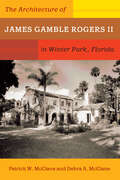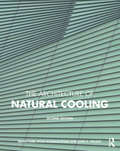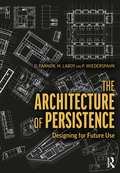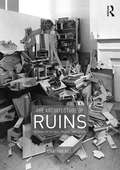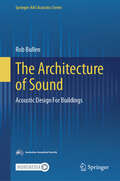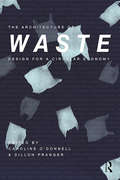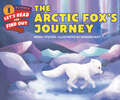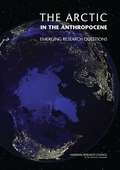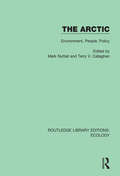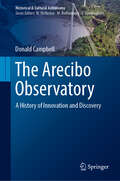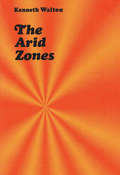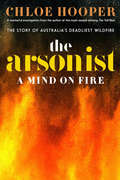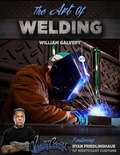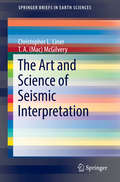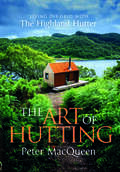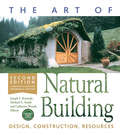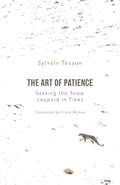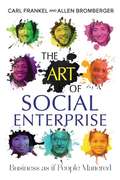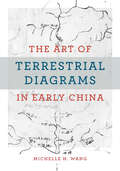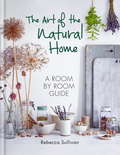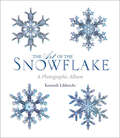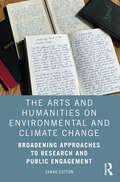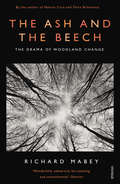- Table View
- List View
The Architecture of James Gamble Rogers II in Winter Park, Florida
by Patrick W. McClane Debra A. McClaneExploring the life and career of one of Florida's premier architectsThis well-illustrated book illuminates the life and career of one of Florida's premier architects, whose elegant homes and design aesthetic shaped the architectural character of Winter Park and influenced urban development throughout central Florida.James Gamble Rogers II (1901-1990) created homes known for their human scale and proportion and for their suitability to the environment. This work highlights twelve of these residences designed for Winter Park, the beautiful small city adjacent to Orlando and the headquarters of the Rogers family architecture firm, Rogers, Lovelock, and Fritz, which exists today under the leadership of Rogers' son. Ingeniously meeting the special needs of Florida's climate—heat, humidity, termite control, and air circulation--the residences incorporate details from a variety of historical styles, including eccletic and authentic features that emulate vernacular Spanish farmhouses and villas.The book includes critiques of each design and its evolution, particulars about the site, and stories about the lives and tastes of the clients—men and women of wealth and status who influenced the heady era of the Florida land boom in the 1920s and 1930s. Numerous floor plans, modern and historical photographs, and Rogers' own drawings augment the discussion.The book also presents an entertaining biography of Rogers, with information on his schooling, a history of the firm he founded, and his familial connections with the architectural profession (his uncle and namesake designed more than 20 buildings for Yale University). It describes his success in the areas of governmental, military, and university architecture, including his designs for buildings at Rollins College in Winter Park, and evaluates his impact on 20th-century architecture in Florida and throughout the nation.Coauthors Patrick and Debra McClane have studied Rogers' original drawings, toured his homes, and interviewed clients and family members; Patrick McClane worked at the Rogers firm during the architect's last years there and brings a personal connection to this work. Their book documents an exceptional contribution to Florida's architectural heritage, the life and work of a man who created stylish and desirable homes and distinctive public buildings.With a detailed appendix that lists dates and addresses for nearly 275 houses, most of them still extant, the work will serve as the definitive guide to Rogers' work in Winter Park.
The Architecture of Natural Cooling
by Brian Ford Rosa Schiano-Phan Juan A. VallejoOverheating in buildings is commonplace. This book describes how we can keep cool without conventional air-conditioning: improving comfort and productivity while reducing energy costs and carbon emissions. It provides architects, engineers and policy makers with a ‘how-to’ guide to the application of natural cooling in new and existing buildings. It demonstrates, through reference to numerous examples, that natural cooling is viable in most climates around the world. This completely revised and expanded second edition includes: An overview of natural cooling past and present. Guidance on the principles and strategies that can be adopted. A review of the applicability of different strategies. Explanation of simplified tools for performance assessment. A review of components and controls. A detailed evaluation of case studies from the USA, Europe, India and China. This book is not just for the technical specialist, as it also provides a general grounding in how to avoid or minimise air-conditioning. Importantly, it demonstrates that understanding our environment, rather than fighting it, will help us to live sustainably in our rapidly warming world.
The Architecture of Persistence: Designing for Future Use
by David Fannon Michelle Laboy Peter WiederspahnThe Architecture of Persistence argues that continued human use is the ultimate measure of sustainability in architecture, and that expanding the discourse about adaptability to include continuity as well as change offers the architectural manifestation of resilience. Why do some buildings last for generations as beloved and useful places, while others do not? How can designers today create buildings that remain useful into the future? While architects and theorists have offered a wide range of ideas about building for change, this book focuses on persistent architecture: the material, spatial, and cultural processes that give rise to long-lived buildings. Organized in three parts, this book examines material longevity in the face of constant physical and cultural change, connects the dimensions of human use and contemporary program, and discusses how time informs the design process. Featuring dozens of interviews with people who design and use buildings, and a close analysis of over a hundred historic and contemporary projects, the principles of persistent architecture introduced here address urgent challenges for contemporary practice while pointing towards a more sustainable built environment in the future. The Architecture of Persistence: Designing for Future Use offers practitioners, students, and scholars a set of principles and illustrative precedents exploring architecture’s unique ability to connect an instructive past, a useful present, and an unknown future.
The Architecture of Ruins: Designs on the Past, Present and Future
by Jonathan HillThe Architecture of Ruins: Designs on the Past, Present and Future identifies an alternative and significant history of architecture from the sixteenth century to the twenty-first century, in which a building is designed, occupied and imagined as a ruin. This design practice conceives a monument and a ruin as creative, interdependent and simultaneous themes within a single building dialectic, addressing temporal and environmental questions in poetic, psychological and practical terms, and stimulating questions of personal and national identity, nature and culture, weather and climate, permanence and impermanence and life and death. Conceiving a building as a dialogue between a monument and a ruin intensifies the already blurred relations between the unfinished and the ruined and envisages the past, the present and the future in a single architecture. Structured around a collection of biographies, this book conceives a monument and a ruin as metaphors for a life and means to negotiate between a self and a society. Emphasising the interconnections between designers and the particular ways in which later architects learned from earlier ones, the chapters investigate an evolving, interdisciplinary design practice to show the relevance of historical understanding to design. Like a history, a design is a reinterpretation of the past that is meaningful to the present. Equally, a design is equivalent to a fiction, convincing users to suspend disbelief. We expect a history or a novel to be written in words, but they can also be delineated in drawing, cast in concrete or seeded in soil. The architect is a ‘physical novelist’ as well as a ‘physical historian’. Like building sites, ruins are full of potential. In revealing not only what is lost, but also what is incomplete, a ruin suggests the future as well as the past. As a stimulus to the imagination, a ruin’s incomplete and broken forms expand architecture’s allegorical and metaphorical capacity, indicating that a building can remain unfinished, literally and in the imagination, focusing attention on the creativity of users as well as architects. Emphasising the symbiotic relations between nature and culture, a building designed, occupied and imagined as a ruin acknowledges the coproduction of multiple authors, whether human, non-human or atmospheric, and is an appropriate model for architecture in an era of increasing climate change.
The Architecture of Sound: Acoustic Design For Buildings (Springer-AAS Acoustics Series)
by Rob BullenThis book highlights the range of issues involved in designing interior spaces for acoustics—that is, ensuring that the sound of a space matches its function. The book presents the principles of acoustic design, together with practical advice on how to apply those principles. The fundamental elements of background sound, intruding sound, sound quality, and speech intelligibility are each described, with design goals, calculation procedures, and advice on implementation. Contemporary challenges associated with integrating acoustics and sustainable building design are also covered. Finally, two types of space—school classrooms and hospital wards—are considered in detail, as examples.
The Architecture of Waste: Design for a Circular Economy
by Caroline O’DonnellGlobal material crises are imminent. In the very near future, recycling will no longer be a choice made by those concerned about the environment, but a necessity for all. This means a paradigm shift in domestic behavior, manufacturing, construction, and design is inevitable. The Architecture of Waste provides a hopeful outlook through examining current recycling practices, rethinking initial manufacturing techniques, and proposing design solutions for second lives of material-objects. The book touches on a variety of inescapable issues beyond our global waste crisis including cultural psyches, politics, economics, manufacturing, marketing, and material science. A series of crucial perspectives from experts cover these topics and frames the research by providing a past, present, and future look at how we got here and where we go next: the historical, the material, and the design. Twelve design proposals look beyond the simple application of recycled and waste materials in architecture—an admirable endeavor but one that does not engage the urgent reality of a circular economy—by aiming to transform familiar, yet flawed, material-objects into closed-loop resources. Complete with over 150 color images and written for both professionals and students, The Architecture of Waste is a necessary reference for rethinking the traditional role of the architect and challenging the discipline to address urgent material issues within the larger design process.
The Arctic Fox's Journey (Let's-Read-and-Find-Out Science 1)
by Wendy PfefferRead and find out about the arctic fox’s quest for survival in this colorfully illustrated nonfiction picture book.During the winter, the arctic fox begins an incredible journey. She heads north through the tundra, toward the top of the world. No larger than a house cat, she faces treacherous obstacles, frightening predators, and bitter cold along the way. It seems impossible that she could persist against the elements on her almost 2,000-mile journey—but she does.This is a clear and appealing science book for early elementary age kids, both at home and in the classroom. The Arctic Fox’s Journey is filled with gorgeous, accurate art and includes tons of visual aids like charts, sidebars, an infographic, as well as a hands-on activity all about camouflage.This is a Level 1 Let's-Read-and-Find-Out, which means the book explores introductory concepts perfect for children in the primary grades. The 100+ titles in this leading nonfiction series are:hands-on and visualacclaimed and trustedgreat for classroomsTop 10 reasons to love LRFOs:Entertain and educate at the same timeHave appealing, child-centered topicsDevelopmentally appropriate for emerging readersFocused; answering questions instead of using survey approachEmploy engaging picture book quality illustrationsUse simple charts and graphics to improve visual literacy skillsFeature hands-on activities to engage young scientistsMeet national science education standardsWritten/illustrated by award-winning authors/illustrators & vetted by an expert in the fieldOver 130 titles in print, meeting a wide range of kids' scientific interestsBooks in this series support the Common Core Learning Standards, Next Generation Science Standards, and the Science, Technology, Engineering, and Math (STEM) standards. Let's-Read-and-Find-Out is the winner of the American Association for the Advancement of Science/Subaru Science Books & Films Prize for Outstanding Science Series.
The Arctic in the Anthropocene: Emerging Research Questions
by Committee on Emerging Research Questions in the ArcticOnce ice-bound, difficult to access, and largely ignored by the rest of the world, the Arctic is now front and center in the midst of many important questions facing the world today. Our daily weather, what we eat, and coastal flooding are all interconnected with the future of the Arctic. The year 2012 was an astounding year for Arctic change. The summer sea ice volume smashed previous records, losing approximately 75 percent of its value since 1980 and half of its areal coverage. Multiple records were also broken when 97 percent of Greenland's surface experienced melt conditions in 2012, the largest melt extent in the satellite era. Receding ice caps in Arctic Canada are now exposing land surfaces that have been continuously ice covered for more than 40,000 years. What happens in the Arctic has far-reaching implications around the world. Loss of snow and ice exacerbates climate change and is the largest contributor to expected global sea level rise during the next century. Ten percent of the world's fish catches comes from Arctic and sub-Arctic waters. The U. S. Geological Survey estimated that up to 13 percent of the world's remaining oil reserves are in the Arctic. The geologic history of the Arctic may hold vital clues about massive volcanic eruptions and the consequent release of massive amount of coal fly ash that is thought to have caused mass extinctions in the distant past. How will these changes affect the rest of Earth? What research should we invest in to best understand this previously hidden land, manage impacts of change on Arctic communities, and cooperate with researchers from other nations? "The Arctic in the Anthropocene" reviews research questions previously identified by Arctic researchers, and then highlights the new questions that have emerged in the wake of and expectation of further rapid Arctic change, as well as new capabilities to address them. This report is meant to guide future directions in U. S. Arctic research so that research is targeted on critical scientific and societal questions and conducted as effectively as possible. "The Arctic in the Anthropocene" identifies both a disciplinary and a cross-cutting research strategy for the next 10 to 20 years, and evaluates infrastructure needs and collaboration opportunities. The climate, biology, and society in the Arctic are changing in rapid, complex, and interactive ways. Understanding the Arctic system has never been more critical; thus, Arctic research has never been more important. This report will be a resource for institutions, funders, policy makers, and students. Written in an engaging style, "The Arctic in the Anthropocene" paints a picture of one of the last unknown places on this planet, and communicates the excitement and importance of the discoveries and challenges that lie ahead.
The Arctic: Environment, People, Policy (Routledge Library Editions: Ecology #10)
by Mark Nuttall Terry V. CallaghanOriginally published in 2000, The Arctic provides a comprehensive overview of the region's rapidly changing physical and human dimensions, and demonstrates the importance of communication between natural scientists, social scientists, and local stakeholders in response to the tremendous challenges and opportunities facing the Arctic. It is an essential resource for all Arctic researchers, particularly those developing multidisciplinary projects. It provides an overview of key areas of Arctic research by renowned specialists in the field, and each chapter forms a detailed, varied and accessible account of current knowledge. Each author introduces the subject to a specialist readership, while retaining intellectual integrity and relevance for specialists. Overall, the richness of the material presented in this volume reflects the ecological and cultural diversity of this vast and environmentally critical part of the globe.
The Arecibo Observatory: A History of Innovation and Discovery (Historical & Cultural Astronomy)
by Donald CampbellWritten by its former Director, this book presents a historical account of the famous Arecibo Observatory and its 305-meter radio astronomical telescope, widely known for its groundbreaking scientific discoveries and starring role in the James Bond movie, Golden Eye.The story details the planning, funding and construction of the telescope; the people who masterminded and contributed to the project; and the involvement of the US Department of Defense in funding the construction. It also includes the seminal scientific achievements in the three research areas to which the telescope contributed, ionospheric physics, planetary science and radio astronomy.The book continues through later upgrades made to the site, showing how the Arecibo telescope has arguably remained the world’s most versatile and productive radio science instrument for over 50 years. This historical account will fascinate astronomers and historians of science, serving as a valuable contribution to the history of 20th century astronomy.
The Arid Zones
by Hilton KramerThe hot and temperate deserts and their marginal steppe lands comprise one-third of the land surface of the world and are an increasingly critical area for the economic wellbeing of world populations. The remarkable mechanisms of floral, faunal, and human adaptation to the distinct and difficult environment of these arid zones, as well as the potential of modern technology for facilitating adaptation, are described and explained by Walton in the light of our most recent knowledge of the phenomena and processes involved.Beginning with a clarification of the definitions of arid and semi-arid regions and with the delineation of techniques for measuring the degree of aridity in these areas, the author shows that there is wide variation among the arid zones in landscape and climate and that there are numerous local and microclimates within any single arid region. The life cycles of the plants and animals of the arid zones are described and the water resources, including problems of salinity, mineral contamination, and the construction of reservoirs, are examined. Extensive treatment is given to potential agricultural adaptations and to pastoralism as the most widespread response to dry land. A final chapter summarizes attempts at adaptation to prevailing drought and discusses the kinds of future development that the author deems most likely in arid zones.Throughout the book emphasis is placed on specific, detailed analysis, with adequate tables and formulas for in-depth understanding of particular aspects of aridity. Examples from both Old and New Worlds are used to demonstrate the spheres in which progress is being made and to show the mistakes in past and present land use in arid areas. An essential supplement for courses in physical geography, the book will be useful in many area studies and in studies of economic development.
The Arsonist: A Mind on Fire
by Chloe HooperThe true story of the most devastating wildfire in Australian history and the search for the man who started it.What kind of person would deliberately start a firestorm? What kind of mind? On the scorching February day in 2009 that became known as Black Saturday, a man lit two fires in Victoria's Latrobe Valley, then sat on the roof of his house to watch the inferno. In the Valley, where the rates of crime were the highest in the state, more than thirty people were known to the police as firebugs. But the detectives soon found themselves on the trail of a man they didn't know. The Arsonist takes readers on the hunt for this man, and inside the strange puzzle of his mind. This book is also the story of fire in Australia, and of a community that owed its existence to that very element. The command of fire has defined and sustained us as a species--understanding its abuse will shape our future. A powerful true-crime thriller written with Hooper's trademark lyric detail and nuance, The Arsonist is a reminder that in an age of fire, all of us are gatekeepers.
The Art Of Welding
by William L. Galvery Ryan FriedlinghausRyan Friedlinghaus, the celebrated guru of automotive customization and host of West Coast Customs on Fox Sports, adds practical knowledge to William Galvery's acclaimed welding insight and everyday tips and tricks developed over his long professional career as an educator. This unique and original book improves upon the shortcomings of competitive titles by providing complete, in-depth coverage of the equipment and techniques used in the most popular welding processes: oxyacetylene, stick welding, MIG welding and TIG welding. What's more, it presents information in a lively, easy-to-follow design. Each chapter contains the pros and cons of each process and information on equipment, setup, materials, safety and welding techniques. To provide a solid footing for the novice welder, there is a chapter that provides an overview of welding and another on tools and materials. The bulk of the book is devoted to the more popular welding techniques. The authors also provide a chapter on soldering and brazing and another on plasma cutting. The Art of Welding is perfect for anyone who wants to learn welding, to make repairs or as part of a hobby. Even experienced welders will discover many tips and procedures to improve their welding technique. Features: Presents the accumulated experience and knowledge of two welding professionals. William Galvery provides insight to the proper use of equipment and the science behind welding, including how welding affects different metals. Ryan Friedlinghaus provides the tips and techniques he uses everyday at West Coast Customs. Offers in-depth information about all popular welding processes, step-by-step photos and an engaging design that will appeal to do-it-yourselfers and hobbyist who want a solid background in welding. Emphasis is placed on safety with sections on selecting the proper clothing and safety lens for welding. Each welding process includes tips on approaching the job in a safe manner. Contains troubleshooting guides offering users an opportunity to learn from their mistakes by comparing inadequate welds to the troubleshooting guides located throughout the book. A chapter on welding projects shows welders how to compensate for the natural distortion that welding causes to various metals
The Art and Science of Seismic Interpretation (SpringerBriefs in Earth Sciences)
by Christopher L. Liner T. A. McGilveryThis book demystifies that art and science of seismic interpretation for those with and without formal geophysical training. From geologists to managers and investors, The Art and Science of Seismic Interpretation is a guide to what seismic data is, how it is interpreted, and what it can deliver.
The Art and Science of Seismic Interpretation (SpringerBriefs in Earth Sciences)
by Christopher L. Liner T. A. McGilveryThis book demystifies that art and science of seismic interpretation for those with and without formal geophysical training. From geologists to managers and investors, The Art and Science of Seismic Interpretation is a guide to what seismic data is, how it is interpreted, and what it can deliver.
The Art of Hutting: Live Off-Grid with The Highland Hutter
by Peter MacQueenLiving Off-the-Grid in ScotlandDon’t just experience Scottish history. Live it with The Art of Hutting, the essential beginner’s guide to sustainable living off the grid.Experience Scotland like never before. The Land of the Brave has so much to see and offer, but nothing is more breathtaking than living in its natural beauty. So how does one live away from the cities of Scotland? Inspired by traditional and modern shelter techniques, hutting expert Peter MacQueen shares how to live off the grid in The Art of Hutting. Each chapter answers many your questions about local sustainable living, from the safest bushcraft tools to growing a bountiful garden for every season. That way, you can be prepared to create your forever home and make memories in the untamed heart of Scotland.Create your own cozy Scottish hideaway. Along with learning the necessary outdoor skills to live off Scotland’s resources, this self-sufficient living book also shares how to create the hut of your dream. Off-grid living has never been cozier than with MacQueen’s hutting tips and tricks, from constructing the perfect eco-design to finding natural building materials. And with visual examples of local huts and cottages to choose from, you can create your next home with all the beauty and wonders the Scottish highlands and lowlands have to offer.Inside The Art of Hutting, you’ll also find:Best locations for hut buildingHow to create a wildlife garden made from Scotland’s natural vegetationRecommendations for fire-starter tools and firewood storageIf you liked books such as Thrive, Clansland Almanac, or Surviving the Wild, then you’ll love The Art of Hutting.
The Art of Migration: Birds, Insects, and the Changing Seasons in Chicagoland
by John Bates Peggy Macnamara James H. BooneTiny ruby-throated hummingbirds weighing less than a nickel fly from the upper Midwest to Costa Rica every fall, crossing the six-hundred-mile Gulf of Mexico without a single stop. One of the many creatures that commute on the Mississippi Flyway as part of an annual migration, they pass along Chicago’s lakefront and through midwestern backyards on a path used by their species for millennia. This magnificent migrational dance takes place every year in Chicagoland, yet it is often missed by the region’s two-legged residents. The Art of Migration uncovers these extraordinary patterns that play out over the seasons. Readers are introduced to over two hundred of the birds and insects that traverse regions from the edge of Lake Superior to Lake Michigan and to the rivers that flow into the Mississippi. As the only artist in residence at the Field Museum, Peggy Macnamara has a unique vantage point for studying these patterns and capturing their distinctive traits. Her magnificent watercolor illustrations capture flocks, movement, and species-specific details. The illustrations are accompanied by text from museum staff and include details such as natural histories, notable features for identification, behavior, and how species have adapted to environmental changes. The book follows a gentle seasonal sequence and includes chapters on studying migration, artist’s notes on illustrating wildlife, and tips on the best ways to watch for birds and insects in the Chicago area. A perfect balance of science and art, The Art of Migration will prompt us to marvel anew at the remarkable spectacle going on around us.
The Art of Natural Building
by Michael Smith Joseph F. Kennedy Catherine WanekThe popularity of natural building has grown by leaps and bounds, spurred by a grassroots desire for housing that is healthy, affordable, and environmentally responsible. While there are many books available on specific methods such as straw-bale construction, cob, or timber framing, there are few resources which introduce the reader to the entire scope of this burgeoning field.Fully revised and updated, The Art of Natural Building is the complete and user-friendly introduction to natural building for everyone from the do-it-yourselfer to architects and designers. This collection of articles from over fifty leaders in the field is now stunningly illustrated with over two-hundred full-color photographs of natural buildings from around the world. Learn about: The case for building with natural materials, from the perspectives of sustainability, lifestyle, and health What you need to know to plan and design your own beautiful and efficient natural home Explanations of thirty versatile materials and techniques, with resources on where to go for further information on each How these techniques are being used to address housing crises around the world. Clearly written, logically organized, and beautifully illustrated, The Art of Natural Building is the encyclopedia of natural building.Joseph F. Kennedy is a designer, builder, writer, artist, educator, and co-founder of Builders Without Borders.Michael G. Smith is a respected workshop instructor, consultant, and co-author of the best-selling book The Hand-Sculpted House.Catherine Wanek is a co-founder of Builders Without Borders and author/photographer of The Hybrid House and The New Straw Bale Home.
The Art of Patience: Seeking the Snow Leopard in Tibet
by Sylvain TessonWinner of the Prix Renaudot 2019 A New York Times Best Book of 2021 &‘Extraordinarily beautiful… a long last loving glance at the planet.&’ Carl Safina, author of Becoming Wild The Art of Patience sees the renowned French adventurer and writer set off for the high plateaux of remotest Tibet in search of the elusive snow leopard. There, in the company of leading wildlife photographer Vincent Munier and two companions, at 5,000 metres and in temperatures of -25ºC, the team set up their hides on exposed mountainsides, and occasionally in the luxury of an icy cave, to await a visitation from the almost mythical beast. This tightly focused and tautly written narrative is simultaneously a dazzling account of an exacting journey, an apprenticeship in the art of patience, an acceptance of the ruthlessness of the natural world and, finally, a plea for ecological sanity. A small masterpiece, it is one of those books that demands to be read again and again.
The Art of Social Enterprise
by Allen Bromberger Carl FrankelThe current business-for-profit model rewards short-term thinking, narrow self-interest, and a social-and-environmental-costs-be-damned attitude. Nonprofits, while more focused on the greater good, tend to be inherently resource-challenged and rely on increasingly scarce grants and donations to sustain their existence. Social enterprise is an exciting, blended model driven by the desire to create positive change through entrepreneurial activities.The Art of Social Enterprise is a practical guide that supplies everything you need to know about the mechanics of social entrepreneurship including:Startup-envisioning and manifesting intentionStrategic planning-balancing social and monetary valueMaintaining an even keel despite the inevitable challenges associated with being an entrepreneurThis valuable resource also provides an unparalleled legal perspective to help you take advantage of established legal organizational forms, recent statutory creations, contract hybrids, certification programs and more.Aimed at emerging as well as established social entrepreneurs, for-profit leaders who want to introduce an element of social responsibility into their companies, and nonprofit organizations who want to increase their stability by generating income, The Art of Social Enterprise is the definitive guide to doing well while doing good.Carl Frankel has been writing about green business for over two decades and is a serial social entrepreneur and acknowledged thought leader in his own right. He has extensive experience consulting for for-profits, nonprofits, and social enterprises.Allen Bromberger is the leading social enterprise lawyer in North America. Over the years, he has advised thousands of social entrepreneurs: his expertise is as broad as it is deep and specialized.
The Art of Terrestrial Diagrams in Early China
by Michelle H. WangA study of early Chinese maps using interdisciplinary methods. This is the first English-language monograph on the early history of maps in China, centering on those found in three tombs that date from the fourth to the second century BCE and constitute the entire known corpus of early Chinese maps (ditu). More than a millennium separates them from the next available map in the early twelfth century CE. Unlike extant studies that draw heavily from the history of cartography, this book offers an alternative perspective by mobilizing methods from art history, archaeology, material culture, religion, and philosophy. It examines the diversity of forms and functions in early Chinese ditu to argue that these pictures did not simply represent natural topography and built environments, but rather made and remade worlds for the living and the dead. Wang explores the multifaceted and multifunctional diagrammatic tradition of rendering space in early China.
The Art of the Natural Home
by Rebecca SullivanThis book is perfect for those interested in sustainability, natural products and mindfulness. It's all about taking the time to create your own homemade products, from facemasks to floor polish and from medicinal honey to massage oil. Taking inspiration from her grandmother's generation, Rebecca Sullivan has put together this thoughtful and appealing manual to caring for yourself and your home. Traditional methods are resurrected or updated to suit the modern home, using simple, natural ingredients.The first part of the book is dedicated to the Home, and covers cleaning products for every room, recipes for pickles and preserves, and tips on everything from natural laundry treatments to how to grow your own cocktail garden. The second part covers Health & Beauty, and includes bath salts, make up, serums, perfumes and even beard oil, as well as healing remedies such as burn salves and herbal teas. This inspiring guide is a must for anyone interested in living a simpler, more purposeful life.
The Art of the Snowflake: A Photographic Album
by Kenneth LibbrechtThe perfect geometry and exquisite beauty of nature is nowhere so clear to us as in the snowflake. But how have we been able to appreciate this infinitesimal wonder in all its crystalline glory? This book, as much a work of art as a testament to science, reveals how one of the snowflake&’s most inspired photographers came to such intimate knowledge of his craft and its fleeting focus. Beautiful pictures illustrate Kenneth Libbrecht&’s story of the microphotography of snow crystals, from the pioneering work of Wilson Bentley in the 1890s right up to Ken&’s own innovations in our age of digital images. A breathtaking look at the works of art that melt in an instant, this is a book to page through and savor, season after season.
The Arts and Humanities on Environmental and Climate Change: Broadening Approaches to Research and Public Engagement
by Sarah SuttonThe Arts and Humanities on Environmental and Climate Change examines how cultural institutions and their collections can support a goal shared with the scientific community: creating a climate-literate public that engages with environmental issues and climate change in an informed way. When researchers, curators, and educators use the arts and humanities to frame discussions about environmental and climate change, they can engage a far wider public in learning, conversation, and action than science can alone. Demonstrating that archival and object-based resources can act as vital evidence for change, Sutton shows how the historical record, paired with contemporary reality, can create more personal connections to what many consider a remote experience: the changing climate. Providing valuable examples of museum collections used in discussions of environmental and climate change, the book shares how historic images and landscape paintings demonstrate change over time; and how documentary evidence in the form of archaeological reports, ships logs, Henry David Thoreau’s journals, and local reports of pond hockey conditions are being used to render climate data more accessible. Images, personal records, and professional documents have critical roles as boundary objects and proxy data. These climate resources, Sutton argues, are valuable because they make climate change personal and attract a public less interested in a scientific approach. This approach is underused by museums and their research allies for public engagement and for building institutional relevancy. The Arts and Humanities on Environmental and Climate Change will be most interesting to readers looking for ways to broaden engagement with environmental and climate issues. The ideas shared here should also act as inspiration for a broad spectrum of practitioners, particularly those writing, designing, and curating public engagement materials in museums, for wider research, and for the media.
The Ash and The Beech: The Drama of Woodland Change
by Richard MabeyFrom ash die-back to the Great Storm of 1987 to Dutch elm disease, our much-loved woodlands seem to be under constant threat from a procession of natural challenges. Just when we need trees most, to help combat global warming and to provide places of retreat for us and our wildlife, they seem at greatest peril. But these dangers force us to reconsider the narrative we construct about trees and the roles we press on them.In this now classic book, Richard Mabey looks at how, for more than a thousand years, we have appropriated and humanised trees, turning them into arboreal pets, status symbols, expressions of fashionable beauty - anything rather than allow them lives of their own. And in the poetic and provocative style he has made his signature, Mabey argues that respecting trees' independence and ancient powers of survival may be the wisest response to their current crises. Originally published with the title Beechcombings, this updated edition includes a new foreword and afterword by the author.
